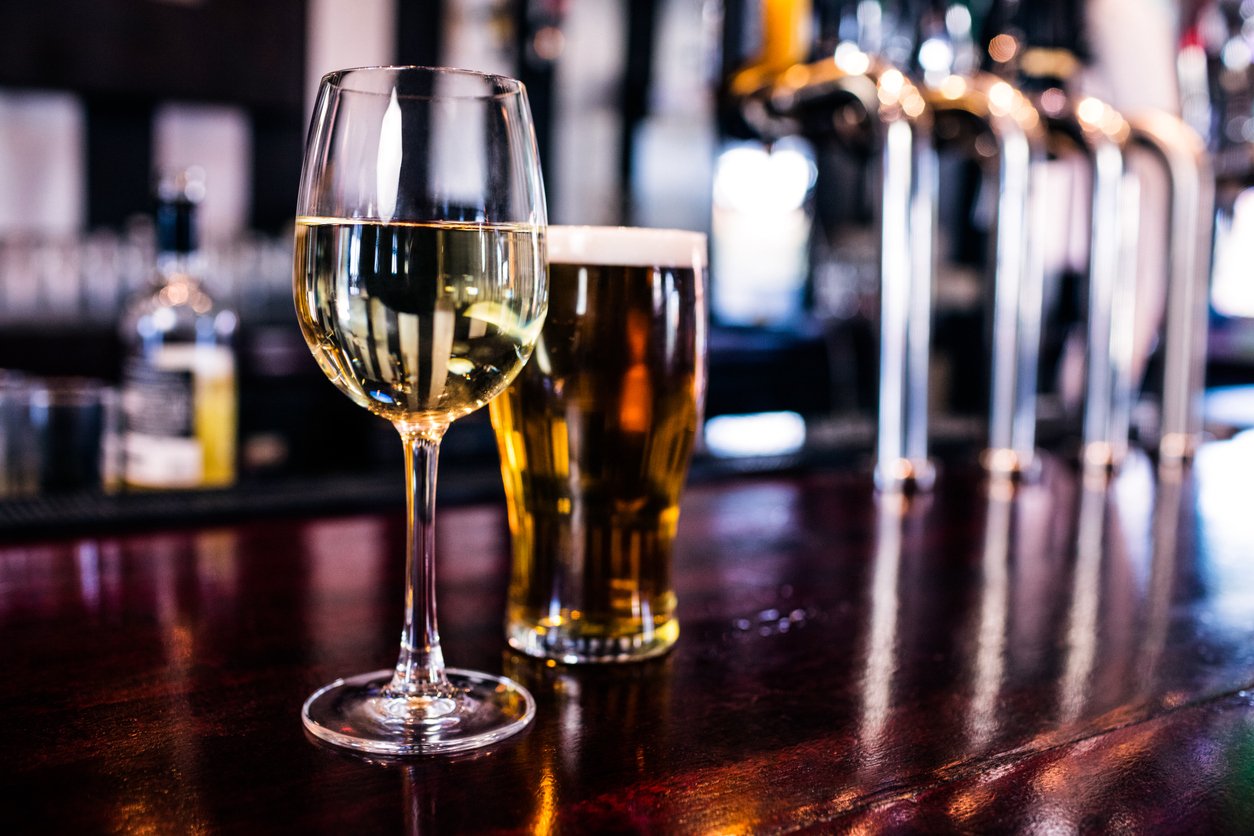David Lynch examines the impact that the Covid-19 pandemic has had on alcohol use and
policy changes affecting the area, such as the recent introduction of minimum unit pricing
The State’s public health strategy for drug use, including alcohol, was published in July 2017. The authors of Reducing Harm, Supporting Recovery: A health-led response to drug and alcohol use in Ireland 2017–2025 could not have foreseen the pandemic and the massive repercussions Covid-19 has had on alcohol use in Ireland. Since March 2020, pubs, restaurants, and nightclubs have been placed under various levels of stringent public health measures, including a period of more than 500 days between 2020-21 when they were entirely shut. Currently, at the time of writing, pubs and restaurants must close at 8pm.
The disruption to the nation’s drinking habits is unprecedented. What this has meant for alcohol consumption and all its current and future ramifications for health is still being worked out. The “clear and obvious impact” of the Covid-19 pandemic on alcohol use “has been a further shift from on-trade alcohol use, such as pubs, clubs, and restaurants to home drinking purchased from the off-trade” in supermarkets, convenience stores, and neighborhood shops, Prof Frank Murray, Chair of the Alcohol Health Alliance and Consultant Gastroenterologist, told the Medical Independent (MI).
“In 2020, total alcohol consumption in Ireland fell by only 6 per cent despite the licensed premises being closed for 40 weeks,” he said. “Consumers have rediscovered the purchasing power of their euro, which is another good reason for the introduction of minimum unit pricing [MUP].” (See panel, p4).
A Department of Health spokesperson told MI that an upcoming review of the official “low-risk drinking guidelines” would note this “shift towards home drinking” and “take cognisance of these changed drinking patterns”. According to the Healthy Ireland Survey 2021, published last month, 51 per cent of people indicated they drink more, smoke more, have gained weight or report a worsening in their mental health during the pandemic.
Some 42 per cent of drinkers stated they were drinking less, with binge drinking reduced to 15 per cent of the population as compared to 28 per cent pre-pandemic. Forty-four per cent of respondents said their drinking had not changed and 13 per cent said they were drinking more since Covid-19 appeared in our lives.

Parents of children aged under 18 were particularly likely to report an increase in their drinking (16 per cent), with mothers (19 per cent) more likely than fathers (13 per cent) to be drinking more. But the majority of drinkers aged under 35 reported a decrease in their alcohol consumption. Of those drinking more during the pandemic, “the majority did not identify a need to reduce their alcohol consumption to improve their health and wellbeing,” noted the Department, which added that “depending on the extent of consumption increase, this is likely to be of concern”
Dependence
Back in September 2020, GP Dr Garrett McGovern, founder of Priority Medical Clinic, Dublin, told MI the number of patients seeking treatment for alcohol dependence at his clinic had increased by 25 per cent during the early months of the pandemic. He said the rise in alcohol use was in response to Covid-19 and the lockdown measures and around 90 per cent of patients at the clinic were seeking treatment for problem drinking in the home.
“At first we didn’t see any increase, but lately we are seeing a number of cases caused by lockdown and a huge upsurge in drinking in the home,” Dr McGovern said in September 2020. He added that of those presenting for treatment, about 70 per cent were women and 30 per cent men. Now over 16 months deeper into the pandemic, have these initial pandemic patterns continued?
“Interestingly, the trends have continued,” Dr McGovern told this newspaper. “In many ways the trends that occurred during the pandemic were there already pre-pandemic.” He added that working from home has meant many people have started drinking earlier in the day. “Pre-pandemic this would usually happen when people got home from work. But when they started to work from home it was not unusual to start drinking earlier in the day, sometimes as early as lunchtime,” he said.
“It was this change in drinking habits that was a warning flag [to patients] that maybe something was wrong and hence [they started] exploring treatment.” Is increased drinking at home likely to continue for the foreseeable future, or will the ‘end’ of the pandemic halt this course? “This is an excellent question and I am not sure I can answer it sufficiently as I am treating the people who presented for and started treatment, so the focus is addressing these issues,” said Dr McGovern. “There are obviously many more people out there who are not receiving treatment and in those circumstances, it is likely their problem drinking has escalated.
If they continue working from home then it is likely the problem of earlier drinking will continue.” However, he added if people whose problem drinking has escalated during the pandemic “are expected to return to work it is difficult to know what way that will go”. “I have, for example, treated people in that situation who did return to work before I began to treat them and they started to secretly drink there [in work], hence another red flag that something was wrong.”
Emergency departments
The impact of the recent shift in drinking habits has also been experienced in the acute sector. In a 2017 statement, the Irish Association for Emergency Medicine (IAEM) noted that “those working in emergency departments (EDs) in Ireland witness at first hand the devastation caused to people’s lives through alcohol misuse”. Dr Fergal Hickey, Consultant in Emergency Medicine at Sligo University Hospital and President of the IAEM, said there is anecdotal evidence of changes over the last couple of years. “We do still see people with alcohol-related problems, but these were people who are drinking at home,” Dr Hickey told MI.
“So we saw more domestic violence, we saw more people who live in the same house assaulting one another rather than down the town or on the street… more people falling down stairs. So there has been a change in pattern.” He said patients were arriving “at different times of the day” with alcohol-related issues. “We weren’t getting them all between 2am and 3am in the morning. They were coming in more spread out across the day and the week and the incidents were happening more indoors in people’s houses rather than in town. Less street assaults, but there were assaults in homes.”
Public health
Public health doctors have also been highlighting the health consequences arising from alcohol. “Alcohol is directly associated with over 60 acute and chronic conditions,” Dr Ina Kelly, IMO President and Specialist in Public Health Medicine, said last month when welcoming the introduction of MUP. “[These range] from accidents and assaults to mental health problems and suicide, cardiovascular disease, liver cirrhosis, and certain cancers… research shows that there is a direct correlation between the price of alcohol, alcohol consumption, and alcohol-related deaths.”

Clearly, the public health challenge from alcohol predates Covid. Figures from the Health Research Board (HRB) show
there were 54,263 cases of people being treated for problem alcohol use between 2012 and 2018.
Much of the HRB’s fieldwork for the 2019- 20 Irish National Drug and Alcohol Survey was conducted before the pandemic and it found that one-in-five drinkers have an alcohol use disorder (AUD); this increases to one-in-three among drinkers aged 15-to24. Drinkers with AUD were 13 times more likely to experience alcohol-related harm compared to low-risk drinkers, according to the HRB survey.
The report found rates of hazardous and harmful drinking remained high. Two-in-five drinkers engaged in heavy
monthly episodic (binge) drinking. But the HRB survey also found that there had been an increase in the number of people who do not drink, and the age at which young people had their first drink has also risen.
The introduction of minimum unit pricing
Minimum unit pricing (MUP) was introduced earlier this month as part of the Public Health (Alcohol) Act 2018. It sets a minimum price for off-trade alcohol. According to its supporters, its aim is to stop strong alcohol being sold at low prices in off-licences and shops. However, the increase in prices has sparked significant opposition expressed on radio phone-in shows and national print media. One students’ union leader called MUPa “regressive measure” that could
possibly increase the use of illegal drugs.
Retailers have warned that people may travel north of the border to purchase cheaper alcohol (MUP has not yet been introduced in the North). Sinn Féin Health Spokesperson Deputy David Cullinane, and others, have criticised the Government for its failure to ring-fence VAT revenues from MUP for specific addiction services. Other critics have argued that there is evidence the measure will not reduce harmful drinking and that it hits the less well-off in society disproportionately.
However, while the public reaction to MUP may have been mixed, within medical circles there has been strong support.Speaking last month, Dr Ina Kelly, IMO President and Specialist in Public Health Medicine, described it as “a really important public health intervention”. Dr Kelly commented: “For many years along with other health colleagues the IMO has been advocating in favour of measures to reduce the level of alcohol consumption and binge drinking particularly among young people.”
She added that she had “no doubt” that MUP “will save lives”. Consultant Gastroenterologist Prof Frank Murray told the Medical Independent it was his view that the criticism of MUP has been “largely motivated by unwillingness to accept that interventions and controls are required to reduce alcohol consumption to reduce alcohol harms”.
“This clash between progressive public health initiatives and vested interests is also going to be somewhat fraught.” On arguments that the measure will have the greatest impact on people from lower socioeconomic groups, he said “MUP and indeed the wider set of measures within the Public Health Alcohol Act, target drinkers and the drivers of consumption, it makes no distinction between socio-economic demographics”.
“The modeling research, which informed MUP from 2014 (Sheffield University, UK), shows that those in the lowest income groups are the least affected as they represent both the highest level of non-drinkers (one-in-three) and better adherence to low-risk drinking guidelines.” In terms of future measures, Prof Murray said he believes “we must
implement the policy framework and the measures within the Act in full”.
“There are a number of significant measures yet to be commenced, which have the capacity to lead out on a generational change, namely transforming the content of alcohol advertising through a statutory code; the provision of accurate health information on all alcohol products [regarding] the inherent risk from alcohol use and ending all alcohol promotion on broadcast media before 9pm.”
He also said that a Statesponsored office to lead on alcohol policy should be established “that would have adequate resources and strategic intent to lead for the coming decades and strive to achieve a society free from alcohol harm”.
‘Effectiveness of one coherent voice’
While all the measures in the Public Health (Alcohol) Act have yet to be enacted, some have come into effect.These include the establishment of enclosures for alcohol in mixed sale shops in late 2020 and now the introduction of MUP. There has been strong and active support for the Act within Irish medicine going back over seven years. However, in 2017, the Medical Independent (MI) reported on concerns raised by public health doctors about the lobbying from industry against the Bill.
One doctor compared it to “David versus Goliath”. Now in 2022, what can be learned from the campaign? The establishment of an alcohol policy framework, as enacted within the Act, was “the first time Ireland has sought to address alcohol-related harm as a public health issue”, Consultant Gastroenterologist Prof Frank Murray told MI.
“The… Act, while broadly modest in its objectives, is nevertheless historic and important and very much seeks to take tentative policy measures much in the same way that tobacco consumption and the harms from smoking were identified and addressed.”
Prof Murray said the “major learning” for the public health community from the campaign “is the effectiveness of one coherent voice”. He said that “under the stewardship” of Alcohol Action and the RCPI, the Alcohol Health Alliance Ireland was established. It included nearly 60 medical/public health organisations and leadership figures “under one umbrella”. It has “led with one voice on the need for progressive alcohol policy that would reduce the burden from alcohol-related harm”, according to Prof Murray.
“It is regrettable that evidence-based measures were opposed so vigorously by the alcohol industry and delayed through parliamentary obstructionism, but this too has been a learning curve, not just to our alliance, but to a wider international partnership who face similar challenges.”













Leave a Reply
You must be logged in to post a comment.